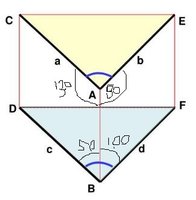Dr.Peterson
Elite Member
- Joined
- Nov 12, 2017
- Messages
- 16,605
Is there a link to a digital book in space geometry (neither trigonometry nor vectors) that includes claims / theorems and proofs?
In my language, there is no such book, nor paper / plain and digital ...
The above space geometry is neglected in my country's methodology
I think solid geometry is somewhat neglected in my country as well! I have seen old high school books on solid geometry in used book sales, but the standard curriculum doesn't tend to include it, beyond measurement of solid figures. Part of what I was trying to ask you was, what have you been taught about solid geometry on which to base a proof? Evidently your point has been that you don't have that foundation.
If you want to study it, you might start by going through the part of Euclid's Elements that deal with the subject, namely Book XI.
Looking through that, I notice that he gives the definition of the angle between two planes that you are using (though you initially didn't state that the angles you use are perpendicular to the intersection line, which was what I was trying to draw out of you):
The inclination of a plane to a plane is the acute angle contained by the straight lines drawn at right angles to the intersection at the same point, one in each of the planes.
As the source I'm linking to says, though,
As the previous definition requires certain assumptions, so does definition 6. It assumes that any two such acute angles are equal, something Euclid does not prove but could have in the course of Book XI.
This is too common in Euclid! But see if you can use the propositions in this book to make the proof you want.
Looking for a more recent book, by searching for "solid geometry textbook", I find this 1919 book, for one:

Solid Geometry with Problems and Applications (Revised edition) by H. E. Slaught et al.
Free kindle book and epub digitized and proofread by volunteers.
Theorem XVI (section 111, p. 30) and its corollaries amounts to what you are asking about; you may or may not be satisfied with its proof, depending on what axioms you accept.
Here is a 1912 book with similar content:
Theorem XX (section 673, p. 324) is your theorem, stated a little differently.
I hope this helps a little. I, too, wish there were more available about synthetic (axiomatic) geometry of solids; other approaches, such as vectors and analytic geometry, are certainly more popular today (though probably for good reason).




